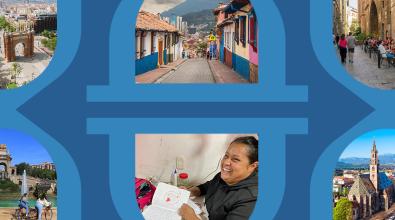Future watch: What's next for behavioral 'nudges'? Here's what the experts say

Photo source: Shutterstock
Behavioral science has come a long way in city government in a short amount of time. City leaders have, in less than a decade, become adept at using simple but rigorously tested “nudges” to improve tax collections, recruit diverse police candidates, boost library card renewals, and more. And they’re doing so with great results: A recent U.S. study found that nudges, on average, improved desired outcomes by about 8 percent.
Yet local leaders have only scratched the surface of all they can do with behavioral science, according to David Halpern, CEO of the Behavioral Insights Team, or BIT, a consultancy that grew out of the U.K.’s “Nudge Unit.” Through a partnership with Bloomberg Philanthropies, BIT has teamed up with 67 U.S. cities to integrate nudges into their work. “Imagine that for all the things that happen in the city, you could pull a switch and get 8 percent better this year and 8 percent better the next year and the next,” Halpern says. “That’s a total game changer, right?”
To learn what’s next in nudges—and how city leaders can get there—Bloomberg Cities caught up with Halpern and another luminary in the field, Elizabeth Linos, a co-author on the study noted above and an Assistant Professor of Public Policy and the founder of The People Lab at the University of California, Berkeley.
Here are 10 new directions these two experts see the use of behavioral insights headed in local government in the years to come.
1. Destigmatizing services. During the pandemic, Linos’ team partnered with Denver on an experiment aimed at encouraging more at-risk residents to apply for emergency rental assistance. The test showed that social stigma around taking government help is a big barrier—one that can be overcome, particularly among Black and Hispanic residents, by changing the language around how aid is offered. On the supply side of housing, Linos is now looking at whether similar destigmatizing techniques might encourage more landlords to take tenants using Section 8 housing vouchers.
There’s a big role for behavioral science in figuring out “what it means to destigmatize government assistance programs, what it means to interact with populations that have been historically mistreated by government, and how to rebuild trust,” she says.
[Read our explainer: What is a behavioral ‘nudge’?]
2. Making streets safer. On American roadways—or anywhere people drive on the right side of the road—left-hand turns are particularly dangerous. BIT recently partnered with the San Francisco Metropolitan Transit Authority on a pilot to see whether behavioral science can help make roads safer. Simple interventions such as rubber speed bumps, meant to send drivers a mental signal to slow down, were tested at a number of intersections. Speeds at those intersections dropped by 17 percent. “That’s a nice, relatively light-touch intervention—you’re not digging up the whole road,” Halpern says. “And it’s a stepping stone into thinking about behavioral science in a spatial dimension. In some ways, that’s what cities are all about—places and spaces.”
3. Supporting city hall’s workforce. In a time when local governments are struggling to retain workers in key positions, nudging could help. For example, a recent study Linos led found that simple behavioral interventions reduced burnout and turnover among 911 dispatchers. Much more work is needed here, she thinks—particularly around whether investments in workforce actually lead to better service delivery. “We don’t actually have good evidence to suggest that really investing in a happy and engaged workforce is going to translate meaningfully into better outcomes for residents,” she says.
Linos also thinks there’s room for what she calls “nudging inwards”—or using behavioral science to support those in power around issues like racial equity that require large systemic changes. “The onus should not just be on residents to change their behavior,” she says. “We’re also thinking about using those tools to put the onus on people with decision-making authority to change their behavior.”
[Read: How behavioral ‘nudges’ can reduce burnout among 911 dispatchers]
4. Reducing conflict and crime. There’s lots of room for local leaders to tap behavioral science to improve public safety, Halpern says. Simple “target hardening”—making it harder to commit a crime—can pay big dividends. A favorite example is motorbikes. As more and more jurisdictions require drivers to wear helmets, they tend to see motorbike thefts go down substantially. “If I’m going to steal your motorbike, I also have to remember to bring a helmet,” Halpern says. “It turns out, most crime is impetuous.”
Another example comes from Singapore. The city-state’s “Yellow Ribbon” program has significantly reduced criminal recidivism. One element is an annual running event, where ex-offenders run with their families to raise money to smooth their return to society. “It’s not just about the money,’ Halpern says. “It’s about a mindset that is creating a world in which employers and the city are prepared to welcome back ex-offenders, give them a job, and that their families will give them a second chance, too…. There is work that can be done on the city level that can drive change with really big effects.”
5. Deepening resident engagement. The most innovative local leaders are stepping up efforts to bring residents into decision-making in new ways, and co-designing policies and programs with residents to make sure they solve real problems. Linos thinks there’s a big role for behavioral science in learning what new resident-engagement strategies work and scaling them up.
This could even apply to the design of nudges themselves. Nudging sometimes kicks up controversy among critics who don’t like the idea of government running social experiments. Co-design could help change that. “A big question,” Linos says, “is how do we bring in communities that are affected, and potentially underserved by government, into designing behavioral interventions and measuring success?”
[Read: Meet the ‘nudgers’ who are pushing behavioral science to new levels]
6. Creating safer and more social public spaces. Researchers have understood for a long time that the physical spaces of buildings and public spaces shape our behavior—and can either encourage people to socialize or turn away from each other. This insight became increasingly important at the height of the pandemic and the isolation and loneliness it caused. Yet far too often, Halpern believes, architects and planners continue to ignore what research has to say about the social impacts of their designs. “There are loads of clues in the literature” about how to build social capital and trust between people, he says, “and I’m sure a lot of city leaders know it and sense it. But what we haven’t done is arm them with empirical firepower. It’s still way too trial-and-error with really expensive assets.”
7. Encouraging climate-friendly behaviors. Sometimes, a little peer pressure can be a good thing. When it comes to preventing climate change, Halpern sees room for cities to use that to the planet’s advantage. Take electric vehicles, for example. Cities can encourage residents to take the leap of buying one by organizing bulk purchasing consortiums. Not only do residents typically get a better deal that way, but there’s also encouragement in doing something that others are doing.
Similarly, one way to encourage walking over driving is to turn it into a group activity—say, Walk to Work and School Wednesday. “If we’re all driving, we’re stuck in this equilibrium, but if we jump together, we’d all be much happier,” Halpern says. “A lot of behavior rests on what your neighbors are doing. We know this stuff is literally contagious.”
8. Shaping local markets. Everyone’s been there. You need a plumber. Or a dentist. Or an electrician. How do you know if the one you’re calling is any good? Halpern believes local leaders are well positioned to use behavioral insights to help residents find the answer—and in so doing, raise the quality of businesses and services in their communities. “There’s a case for saying we should ‘Trip Advisor’ everything,” he says, referring to the popular website where travelers rate and review their experiences at hotels, restaurants, and other businesses.
“If you want economic growth or ‘good work’ in your community, you need to know that the market is working well enough that people will be able to tell the difference between good and bad,” Halpern continues. “If I was a mayor, I’d be thinking about this. Now there will be some people who will be like, ‘Wait a minute, I don’t really want you to know if I’m a good or a bad accountant.’ You know who will be worried about that? Bad accountants.”
[Read: 7 Behavioral insights tips from pioneering cities in the field]
9. Scaling this work up. For cities, scaling up the use of behavioral insights is a matter of building both internal and collective capabilities. While cities can always partner with local universities or consultants on projects, Linos says, most could benefit from having in-house skills, especially in scoping out projects where nudges could be useful. “Knowing enough about behavioral science and a city’s own data to be able to see opportunities for potential improvements—that has to be in-house.”
At the same time, Halpern wants to see cities learn from each other’s work more rapidly. “It’s a bit mad for every city to reinvent the wheel,” he says. “The mayor who does it should be helping another 99 mayors, so they bear the costs and all the rest can piggyback on it.”
10. Translating evidence into policy. Local decision makers know a lot more about behavioral science than they did a decade ago. But they still have a long way to go when it comes to incorporating that knowledge and the latest evidence on what works into policy. Linos says that’s a big next step for city halls. “Behavioral scientists all know that you can’t just show people the results and expect that to be adopted,” she says. “The next thing is about supporting cities in translating what we’re learning into policy. Because it’s no one’s job to do that in local government.”
Halpern agrees a lot of work remains to be done in this area. Most of what government does never gets tested, so nobody really knows if it works. “We are literally spending trillions and trillions of dollars and vast amounts of peoples’ time doing things that no one has ever tested as to whether it’s more effective than the alternative,” he says. “If you think about it like a Rogers innovation adoption curve, where you’ve got your early adopters, et cetera—we’re not really very far up that curve if you think about the volume of activity and questions that remain.”




